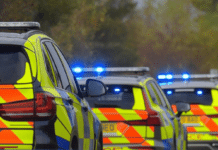Dorset has seen an 8% increase in reported crime, according to statistics for the full financial year from April 2016 to March 2017 that have been released by the Office for National Statistics today (Thursday 20 July).
The rise follows predictions made by Dorset Police over the last few years and is in line with national trends, with an average rise of 10% seen across England and Wales.
Deputy Chief Constable James Vaughan explained: “In 2015 we told the public that we expected crime would start to gradually rise, after over a decade of continual reduction. Dorset is the tenth safest area in England and Wales, so remains an incredibly safe place to live, work and visit. However, we have always pledged to be honest with the public about any rise in crime and to have a mature debate about why this may be happening.
“Over the last two years we have worked closely with Her Majesty’s Inspectorate of Constabulary (HMIC) and the Police and Crime Commissioner to improve our compliance with complex Home Office rules on how crime must be recorded, which has been helped by the introduction of new computer systems. We will continue to place a strong emphasis on our reporting responsibilities, even if this leads to an increase in reported crime, as accurate crime reporting is essential to maintain public trust.
“Like other forces, we have also seen crime rises in recent years due to increased confidence in people coming forwards to us. This is particularly the case for crimes such as domestic abuse and sexual offences, where increased reporting follows a number of high-profile investigations nationally and work locally to support victims. We will continue to focus on safeguarding victims of these types of crime and investigating offences reported to us. The HMIC has commended us on the service we provide to victims, particularly efforts made to protect vulnerable people and to keep the pubic safe from the most dangerous offenders.
“We have also seen significant changes in the way some types of crime are recorded and categorised. Most significantly this year, harassment taking place online is now recorded as violent crime rather than as a telecommunications offence, which has led to large statistical rises in this category.
“However – in addition to statistical rises caused by improved crime recording, increased victim confidence to report, and changing crime categories – we believe that we are now starting to see some increases in crime taking place in local communities. Such rises are being reported nationally and are generally being seen for higher-volume crime types that have lower levels of harm. It is too early to explain exactly why this is happening, as the reasons are likely to be complex, related to societal factors and influenced by changes to services across the whole public sector over the last few years.
“To understand exactly why we are starting to see crime increase – and to identify innovative solutions to help this – we have recently set up a multi-agency group involving the police, councils, the health sector and other local partners. We will report back on the group’s findings later in the year and explain any actions that will be taken by the organisations involved.”
Police & Crime Commissioner Martyn Underhill said: “While Dorset remains a very safe place to live, we must get to grips with why we are starting to see a genuine rise in crime.
“I am reassured that the statistics reflect an increase in lower-harm offences, as opposed to more serious types of crime, but anti-social behaviour and other less serious offences can still have a detrimental impact on residents’ quality of life and a response is needed.
“I have been vocal about the need to reinvest in the totality of policing. During the last decade, the citizen to police officer ratio has increased by 23%, rising from 381 citizens per officer in 2006 to 461 in 2016 at a time of increased demand. It is an undeniable fact that police resourcing has changed; the service needs more money in order to build a safer and more secure future.
“Moreover, policing is operating in an environment where partner organisations across the emergency services, local authorities and the third sector are increasingly stretched. This is a national trend but we need to understand if and how this is impacting upon policing and crime in Dorset. Working with partners in a multi-agency problem-solving forum is something I pledged to do under my new Police & Crime Plan and it is the right approach to take.”
In relation to specific crime types, burglaries of people’s homes reduced by 6.8% (1,585 to 1,478) last year and there was a 16% reduction in vehicles being stolen (over 100 fewer offences). This follows proactive work by police to target prolific offenders involved in acquisitive crime, prevention campaigns to advise the public about security measures, and improvements to preventative technology now used by car manufacturers and home owners.
Violence against the person as an overall category saw a rise of 21% (10,545 to 12,758 offences). As explained above, this was mostly due to an increase in harassment of over 40%, with more than 2000 offences now being recorded in this category including those that occur online. This compares to a much lower number of offences in other violent crime categories, such as an increase of 64 robberies (a 34% rise) and 23 additional ‘most serious violence’ offences (a 17% rise). Police also continue to see a rise in reported sexual offences, up 11.3% (1,165 to 1,297), which is believed to be mostly due to increased confidence in reporting.
The report from the Office for National Statistics also includes the percentage of crimes that are detected each year, with Dorset Police achieving positive criminal justice outcomes in 23.3% of cases last year. This puts the Force in the top quarter nationally (11th out of 43 Home Office forces) for its rate of solving crimes, above the national average of 18.5%.
DCC James Vaughan added: “We understand the public’s interest in detection rates and Dorset is one of the top performing forces nationally in this. However it is also important to emphasise that detecting crime is only one part of keeping Dorset safe and that detections are not the only measure of successful investigations. Although a crime may not have resulted in a criminal justice outcome, each crime reported to us is reviewed and lines of enquiry are investigated.
“While nearly a quarter of reported crimes resulted in criminal justice outcomes, a huge amount of other work takes place that is not recorded as a detection. This includes safeguarding vulnerable victims, working with partners to respond to community issues or resolve anti-social behaviour, protecting the public from dangerous individuals, and organising local restorative justice between victims and offenders.
“It is also honest and realistic to recognise that some crimes simply aren’t solvable, if there are no viable lines of enquiry or if information given to police is not detailed enough to take any further. Nevertheless, Dorset Police ensures that crimes are recorded when allegations are made regardless of the likelihood of them being solved, so people can have trust in us and our awareness of local crime.”











